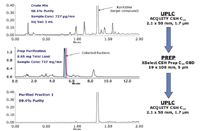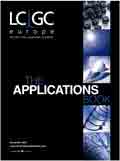Using UPLC Technology as a Method Development Tool for Isolation and Purification in Drug Discovery and Development
Waters Application Note
Kenneth J. Fountain, Jo-Ann M. Jablonski and Damian Morrison, Waters Corporation, Milford, Massachusetts, USA.
Introduction
Isolation and purification of compounds and their impurities/degradants is an important part of the drug discovery and development process. It is critical that a sufficient mass of each compound be isolated and purified for subsequent analysis and testing in the least amount of time to ensure timely identification and characterization. Alternatively UPLC can be used to quickly develop analytical separations using mobile phases that are compatible with preparative chromatography. Once developed, the UPLC method can be easily transferred to the preparative scale using the same stationary phase chemistry and a focused gradient. In this application, ranitidine, the active ingredient in Zantac, is isolated and purified at the preparative scale based on the UPLC separation results. The collected fractions are then analysed with UPLC to rapidly confirm purity. Selectivity of the separation in UPLC and prep is maintained by using ACQUITY CSH and XSelect HPLC columns, which have identical selectivity and differ only in particle size.
Experimental
UPLC system: ACQUITY UPLC system with ACQUITY UPLC PDA detector
Prep system: AutoPurification system with 2996 PDA and AutoPurification flow cell
UPLC column: ACQUITY UPLC CSH C18, 1.7 μm, 2.1 × 50 mm
Prep column: XSelect CSH Prep C18 OBD, 5 μm, 19 × 100 mm
Mobile phase A: 0.1% NH4OH in H2O
Mobile phase B: 0.1% NH4OH in CH3OH
Temperature: 30 °C
Detection: UV 240 nm
Sample diluent: DMSO
Results and Discussion
A generic UPLC screening gradient was used to rapidly analyse ranitidine, the active ingredient in Zantac, which reduces the acid levels in the stomach and is used to treat ulcers and gastroesophageal reflux disease (GERD). The resulting separation is shown in Figure 1 (top chromatogram). Since ranitidine is a base with one of its pKa values at 8.2, it has better retention under high pH mobile phase conditions. Ammonium hydroxide was chosen as the mobile phase modifier because it can be easily removed from purified fractions at the preparative scale when compared to bicarbonate or acetate buffers.
A focused gradient was used at the preparative scale to ensure all other impurities were sufficiently resolved from ranitidine.1 Focused gradients can improve the sample load per injection; increase product yield and purity; and decrease solvent consumption. In order to maintain the separation selectivity of the UPLC separation, the same stationary phase was used in a 5 μm particle size (XSelect CSH C18 Prep OBD column). The preparative isolation of ranitidine on the preparative scale using a focused gradient is shown in the middle chromatogram of Figure 1. Two fractions were collected and then subsequently analysed using UPLC method. The resulting purity was greater than 99% (bottom chromatogram in Figure 1).

Figure 1: Analysis and purification of ranitidine. The UPLC gradient was from 5â95% B in 2 min, at a flow rate of 0.6 mL/min. The preparative gradient had an initial hold at 5% B for 1.21 min, 35.1% B at 1.71 min, 43.1% B at 7.07 min, 95% B at 7.21 min at a flow rate of 25 mL/min.
Conclusions
UPLC can be used as a rapid method development tool for preparative purification and isolation of compounds and their associated impurities/degradants. Directly transferring chromatographic separations between the analytical and preparative column dimensions is accomplished by using the same stationary phase in a different particle size (e.g., ACQUITY UPLC CSH and XSelect HPLC columns). In addition, the use of focused gradients at the preparative scale allows for high resolution separations without increasing run time. Information about focused gradient parameters can be directly obtained from the UPLC analysis.
References
1. J.M. Jablonski, T.E. Wheat and D.M. Diehl, Developing focused gradients for isolation and purification. Waters application note, 720002955EN (2009).

Waters Corporation
34 Maple Street, Milford, Massachusetts 01757, USA
tel. +1 508 478 2000 fax +1 508 478 1990
Website: www.waters.com

Separating Impurities from Oligonucleotides Using Supercritical Fluid Chromatography
February 21st 2025Supercritical fluid chromatography (SFC) has been optimized for the analysis of 5-, 10-, 15-, and 18-mer oligonucleotides (ONs) and evaluated for its effectiveness in separating impurities from ONs.

.png&w=3840&q=75)

.png&w=3840&q=75)



.png&w=3840&q=75)



.png&w=3840&q=75)














